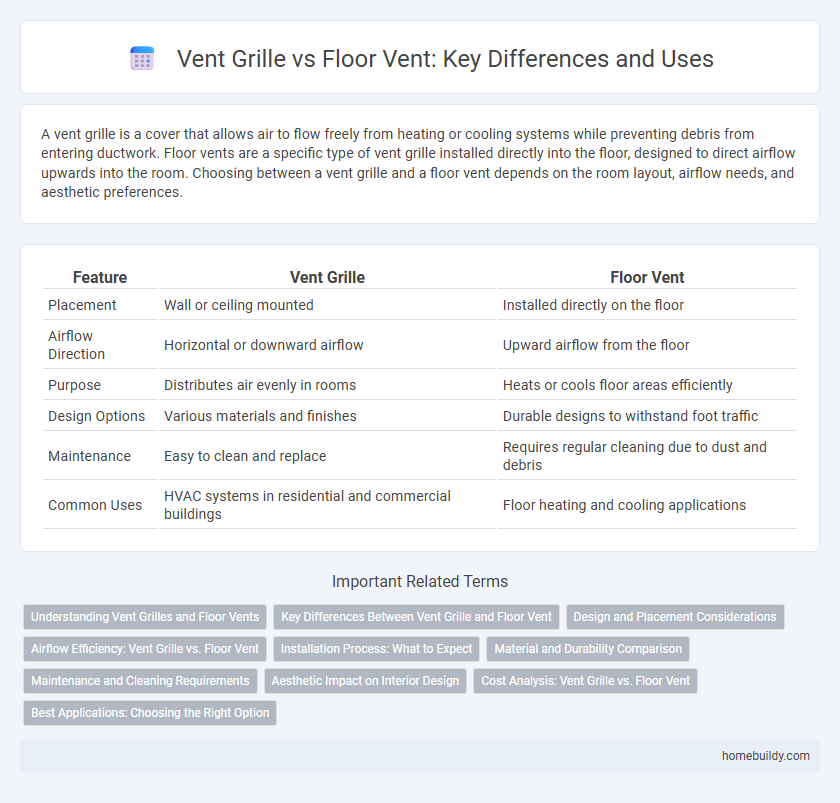A vent grille is a cover that allows air to flow freely from heating or cooling systems while preventing debris from entering ductwork. Floor vents are a specific type of vent grille installed directly into the floor, designed to direct airflow upwards into the room. Choosing between a vent grille and a floor vent depends on the room layout, airflow needs, and aesthetic preferences.
Table of Comparison
| Feature | Vent Grille | Floor Vent |
|---|---|---|
| Placement | Wall or ceiling mounted | Installed directly on the floor |
| Airflow Direction | Horizontal or downward airflow | Upward airflow from the floor |
| Purpose | Distributes air evenly in rooms | Heats or cools floor areas efficiently |
| Design Options | Various materials and finishes | Durable designs to withstand foot traffic |
| Maintenance | Easy to clean and replace | Requires regular cleaning due to dust and debris |
| Common Uses | HVAC systems in residential and commercial buildings | Floor heating and cooling applications |
Understanding Vent Grilles and Floor Vents
Vent grilles are designed to cover air ducts and control airflow dispersion, enhancing ventilation efficiency while maintaining aesthetic appeal. Floor vents function as specific types of vent grilles installed on floors, allowing warm or cool air to flow directly into rooms, which aids in temperature regulation. Understanding the differences between vent grilles and floor vents helps optimize HVAC system performance by selecting the appropriate style, size, and placement for targeted air distribution.
Key Differences Between Vent Grille and Floor Vent
Vent grilles and floor vents serve distinct purposes in HVAC systems, with vent grilles primarily covering air registers on walls or ceilings to regulate airflow direction and prevent debris entry, while floor vents provide direct air distribution into a room from the floor level. Vent grilles often feature adjustable louvers for controlling airflow, whereas floor vents typically have a fixed grate design optimized for heavy foot traffic and easy cleaning. Material composition varies, with vent grilles commonly made from metal or plastic for aesthetics and durability, and floor vents engineered to withstand higher wear from foot traffic and furniture.
Design and Placement Considerations
Vent grilles feature sleek, customizable designs that enhance wall or ceiling aesthetics, while floor vents prioritize durability to withstand foot traffic and furniture placement. Proper placement of vent grilles ensures optimal airflow distribution and prevents obstruction by interior elements, whereas floor vents require strategic positioning to avoid carpet coverage and maintain efficient heating or cooling. Selecting between vent grille and floor vent depends on room layout, style preferences, and functional airflow needs for balanced indoor climate control.
Airflow Efficiency: Vent Grille vs. Floor Vent
Vent grilles typically enhance airflow efficiency by allowing better air distribution due to their adjustable louvers and elevated installation, reducing obstructions compared to floor vents. Floor vents often face airflow restrictions caused by furniture placement and dust accumulation, which can compromise ventilation performance. Optimizing vent grille placement and design ensures improved air circulation and energy efficiency in HVAC systems.
Installation Process: What to Expect
Installing a vent grille typically involves securing the grille over an existing duct opening on a wall or ceiling, requiring precise measurements and often less floor space preparation than floor vents. Floor vent installation demands cutting or fitting into flooring materials, which can be more labor-intensive and may require reinforcing the area to support foot traffic. Expect vent grille installation to be quicker with minimal structural modification, whereas floor vents may necessitate additional tools and steps for safe and secure placement.
Material and Durability Comparison
Vent grilles are commonly made from materials like aluminum, steel, and plastic, offering high durability and resistance to corrosion and wear. Floor vents often utilize heavier metals such as cast iron or steel for enhanced strength to withstand foot traffic and furniture weight. Aluminum vent grilles provide a lightweight, rust-resistant option, while cast iron floor vents deliver superior durability but may require more maintenance to prevent rust.
Maintenance and Cleaning Requirements
Vent grilles installed on walls or ceilings typically require less frequent cleaning compared to floor vents, which accumulate more dust and debris due to their proximity to foot traffic and dirt. Routine maintenance of vent grilles involves vacuuming with a brush attachment and occasional washing with mild soap to prevent dust buildup and maintain airflow efficiency. Floor vents demand more intensive cleaning, including removal for thorough washing and inspection to avoid blockages that could impair HVAC system performance.
Aesthetic Impact on Interior Design
Vent grilles offer a sleek, customizable appearance that seamlessly integrates with wall or ceiling designs, enhancing overall interior aesthetics compared to bulkier floor vents. Their varied styles, finishes, and sizes provide designers flexibility for a cohesive look without disrupting room flow or furniture placement. Unlike floor vents, which can detract from clean flooring lines and accumulate debris, vent grilles maintain a polished, unobtrusive presence that complements both modern and traditional decor.
Cost Analysis: Vent Grille vs. Floor Vent
Vent grilles generally offer a more affordable upfront cost compared to floor vents due to simpler installation and lower material expenses. Maintenance expenses for vent grilles are also typically lower, as they are easier to clean and less prone to blockage or damage. However, floor vents may incur higher costs over time due to increased wear and the need for more frequent repairs or replacements.
Best Applications: Choosing the Right Option
Vent grilles are ideal for wall or ceiling installations where airflow needs to be directed efficiently without obstruction, making them suitable for rooms requiring consistent air circulation and aesthetic integration. Floor vents excel in spaces with lower installations, effectively warming or cooling the room from ground level, particularly in homes with forced-air heating or cooling systems and hardwood floors. Selecting between vent grilles and floor vents depends on room layout, airflow patterns, and flooring type to maximize HVAC system performance and comfort.
vent grille vs floor vent Infographic

 homebuildy.com
homebuildy.com